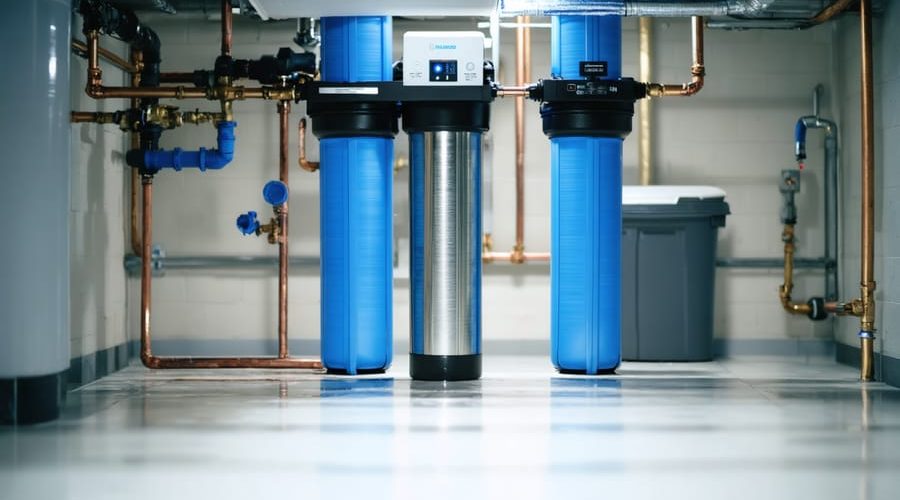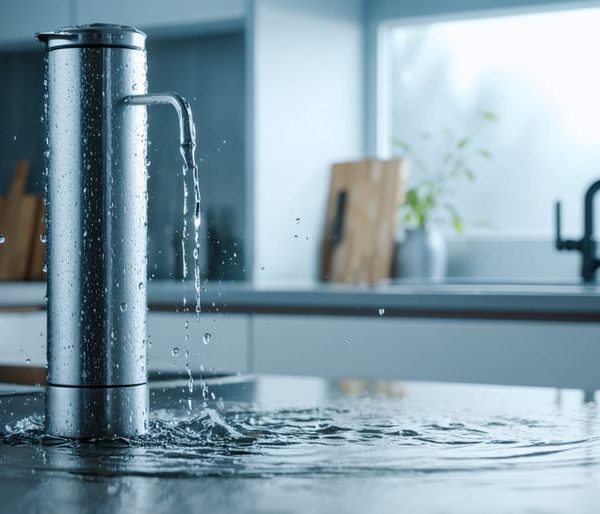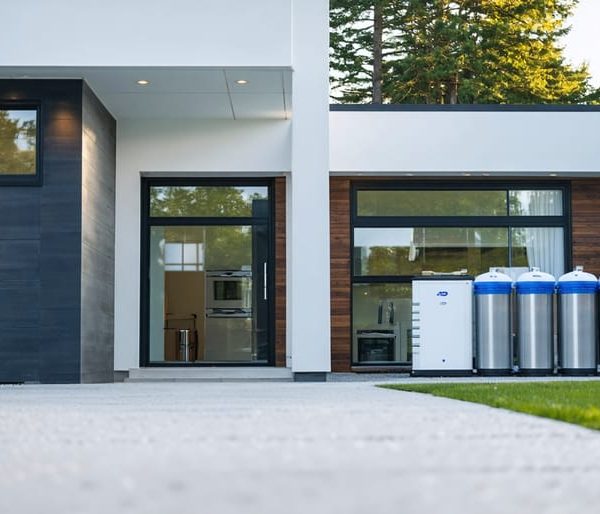Tackle iron and manganese contamination head-on with whole house water filter systems designed specifically to eliminate these stubborn minerals from your entire home’s water supply. When left untreated, these contaminants leave unsightly orange-brown stains on fixtures, damage appliances, and create metallic-tasting water that compromises your family’s daily activities.
Modern filtration technology now offers powerful solutions through multi-stage systems that combine oxidation, filtration, and ion exchange processes. These integrated systems not only remove up to 95% of iron and manganese but also address related issues like hydrogen sulfide and hard water minerals – all while maintaining healthy water pressure throughout your home.
For homeowners battling these persistent water quality issues, whole-house filtration represents a comprehensive solution that protects everything from your morning shower to your washing machine. Unlike point-of-use filters, these systems treat water at its entry point, ensuring every tap in your home delivers clean, clear water that’s free from metallic tastes, stains, and odors.
The right system can transform problematic water into crystal-clear, great-tasting water while protecting your plumbing infrastructure and extending the life of water-using appliances. By addressing iron and manganese at the source, you’ll eliminate the need for constant cleaning of rust stains and ensure your entire household enjoys water that’s as pure as it is practical.
Why Iron and Manganese Are More Than Just Stains
The Tell-Tale Signs in Your Home
If you’re wondering whether your home needs an iron and manganese filtration system, several telltale signs can help you identify the problem. Reddish-brown or black stains in your toilet bowls, sinks, and bathtubs are the most obvious indicators. These stains often appear as rings or streaks and can be difficult to remove with regular cleaning.
Your laundry might also reveal water quality issues. White clothes may develop yellowish or brown discoloration after washing, and darker clothes might appear dull or faded. Another common sign is metallic-tasting water, which can make your morning coffee or tea less enjoyable.
Check your faucets and showerheads for crusty buildup or deposits, which often appear orange or dark brown. You might also notice water appearing clear when first drawn but turning rusty or dark after standing for a few minutes. This change occurs when iron or manganese oxidizes upon exposure to air.
Appliances like dishwashers and water heaters can also show signs of iron and manganese buildup through reduced efficiency and unusual discoloration in and around water connections.
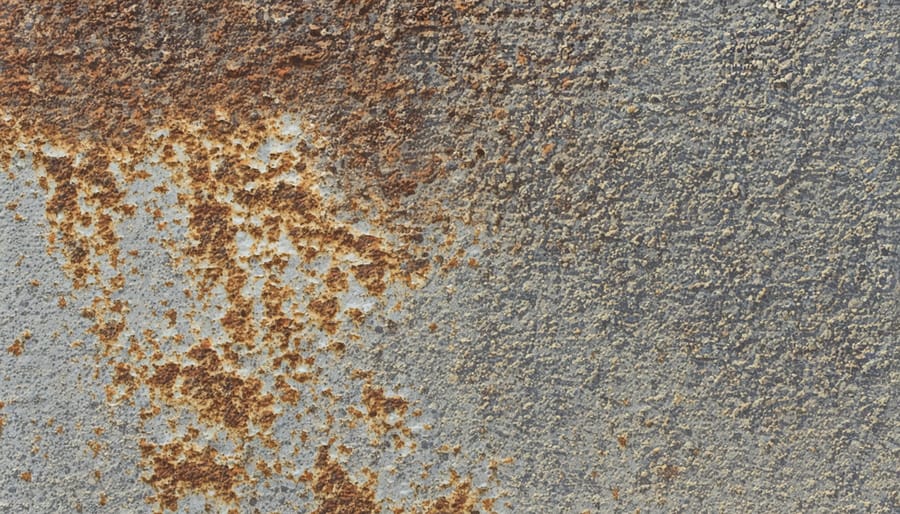
Hidden Damage You Can’t See
While iron and manganese contamination may seem like merely an aesthetic issue, these minerals silently wreak havoc on your home’s infrastructure. Over time, they accumulate inside pipes, gradually narrowing the passageways and reducing water pressure. This buildup can lead to complete pipe blockages, requiring expensive replacements.
Your appliances suffer too. Washing machines, dishwashers, and water heaters become less efficient as mineral deposits coat their internal components. These deposits can cause heating elements to burn out prematurely and valve systems to fail. Even your toilet’s flush mechanisms and faucet aerators can become clogged and damaged.
The financial impact extends beyond repairs. Appliances working harder against mineral buildup consume more energy, leading to higher utility bills. Water heaters with severe iron accumulation can use up to 30% more energy to maintain proper temperature. Additionally, the shortened lifespan of affected appliances means more frequent replacements, creating unnecessary waste and expense.
By addressing iron and manganese contamination early, you protect your home’s entire water system and avoid these costly hidden damages.
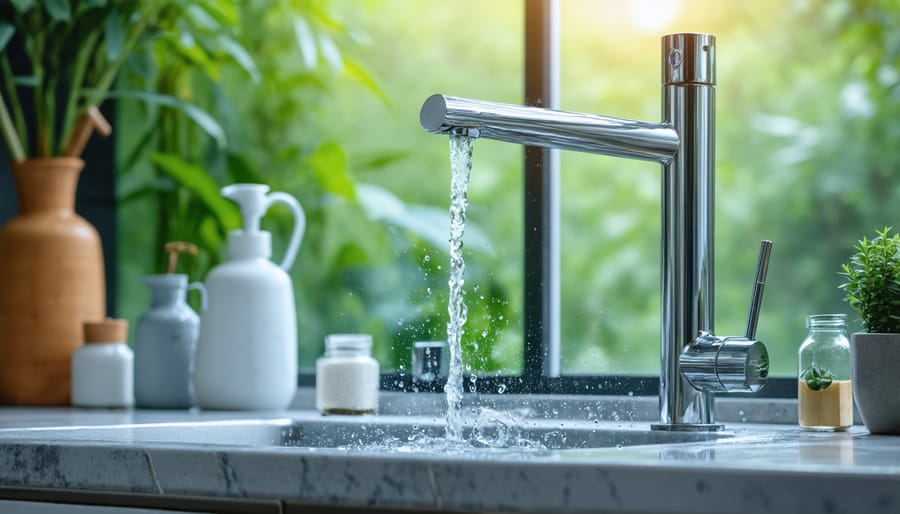
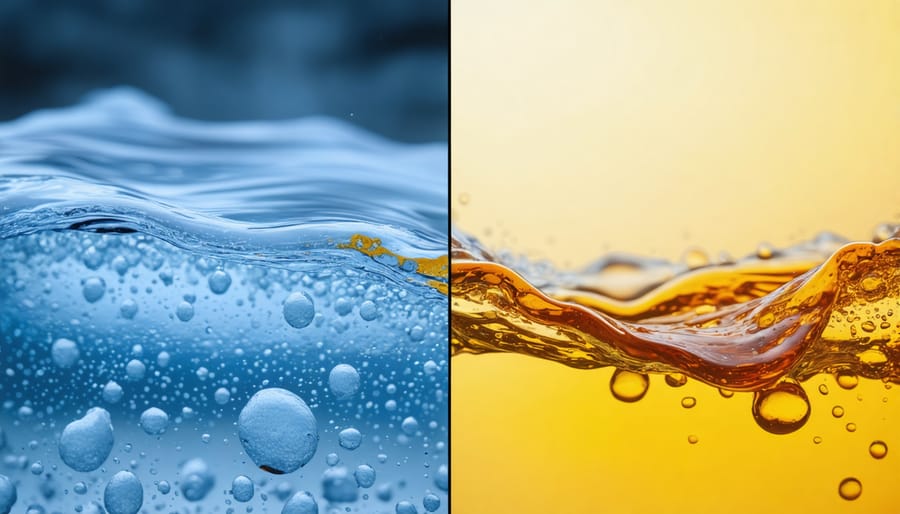
How Whole House Filtration Actually Removes These Minerals
Oxidation: The First Line of Defense
Oxidation is nature’s way of transforming dissolved iron and manganese into particles that can be easily filtered out of your water. This process occurs when these minerals come into contact with oxygen, causing them to change from their clear, dissolved state into visible, rust-colored particles.
In whole house filtration systems, oxidation is deliberately induced as the first step in removing iron and manganese. This can be accomplished through several methods, including air injection, chemical oxidation, or the use of oxidizing filters. When water passes through an oxidation chamber or meets an oxidizing agent, dissolved iron and manganese begin to transform into solid particles.
Air injection systems introduce oxygen-rich air into your water supply through a specialized valve. As the water flows through the system, the dissolved minerals react with the oxygen, forming solid particles. Chemical oxidation typically uses substances like chlorine, hydrogen peroxide, or potassium permanganate to achieve similar results.
The beauty of oxidation lies in its simplicity and effectiveness. Once iron and manganese are oxidized, they become larger particles that can be caught by subsequent filtration stages. This process is particularly effective for water with high iron content, typically removing up to 95% of these troublesome minerals when properly implemented.
Think of oxidation as the prep work before the main filtration event – it sets the stage for successful removal of these unwanted minerals from your household water supply.
Filter Media: The Final Barrier
Filter media serves as the last line of defense in removing iron and manganese from your water supply. The most effective systems typically use a multi-layer approach with different types of media, each serving a specific purpose.
Greensand Plus is a popular choice that excels at removing both iron and manganese through oxidation. This material is coated with manganese oxide, which triggers a chemical reaction that converts dissolved iron and manganese into solid particles that can be easily filtered out.
Catalytic carbon is another powerful option that works particularly well when combined with oxidation systems. This enhanced form of activated carbon not only removes iron and manganese but also helps eliminate unwanted tastes, odors, and other contaminants.
For severe iron problems, many systems incorporate birm, a lightweight media that uses oxygen already present in the water to remove iron efficiently. It’s especially effective when your water’s pH levels are above 6.8.
Mixed media beds, combining materials like anthracite, garnet, and filter sand, create a gradient of filtration that can trap particles of various sizes. This layered approach ensures thorough filtration while maintaining good water flow rates.
When selecting filter media, consider your specific water chemistry and contamination levels. Regular maintenance and occasional media replacement will keep your system operating at peak efficiency.
Choosing the Right System for Your Home
Water Testing: Know Your Enemy
Before investing in a water filtration system, it’s crucial to understand exactly what you’re dealing with in your water supply. Start by conducting a comprehensive water test, which you can obtain through local testing facilities or from top filtration brands that offer testing kits. The test should specifically measure iron and manganese levels, along with other potential contaminants.
For iron, the EPA recommends levels below 0.3 mg/L in drinking water. Manganese should stay under 0.05 mg/L. Higher concentrations can cause staining, metallic taste, and plumbing issues. Pay attention to whether your iron is in dissolved (clear water iron) or oxidized (red water iron) form, as this affects treatment choices.
Keep detailed records of your test results, including seasonal variations. Water composition can change throughout the year, especially if you’re on well water. This information helps you select the most effective filtration system and adjust treatment methods as needed. Regular testing, at least annually, ensures your system continues to perform optimally.
System Sizing and Flow Rates
Determining the right size for your whole house filtration system is crucial for effective iron and manganese removal. Start by calculating your household’s peak water demand – the maximum amount of water needed during high-usage periods. Multiply the number of water fixtures in your home (including faucets, showers, and appliances) by 1-2 gallons per minute (GPM) for an estimate.
For most homes, a system rated between 10-15 GPM is sufficient. However, larger homes with multiple bathrooms or high simultaneous water usage may need systems rated up to 20-25 GPM. Remember that oversizing isn’t necessarily better – a properly sized system ensures optimal contact time between water and filtration media.
Consider your water pressure when selecting system size. Most whole house filters require minimum pressure of 30-40 PSI to function properly. If your water pressure falls below this range, you might need a booster pump to maintain effective filtration.
Check your incoming water flow rate using a simple bucket test: time how long it takes to fill a 5-gallon bucket from your main water line. This measurement helps ensure your chosen system can handle your actual water flow needs.
Must-Have Features
When investing in a whole house filtration system for iron and manganese removal, certain features are essential for optimal performance. First and foremost, a multi-stage filtration process is crucial, typically including sediment pre-filtration to remove larger particles before addressing dissolved minerals.
An oxidation system is vital for converting dissolved iron and manganese into their filterable forms. This can be achieved through air injection or chemical oxidation using potassium permanganate. The system should include a contact tank or sufficient retention time to allow the oxidation process to complete effectively.
The filtration media is particularly important, with specialized materials like Greensand Plus or Birm being highly effective for iron and manganese removal. These media should be contained within a durable tank rated for the appropriate service flow and pressure requirements of your household.
Automatic backwashing capability is non-negotiable, as it prevents media fouling and ensures consistent performance. The control valve should be programmable to schedule regular backwashing cycles based on your water usage patterns and contamination levels.
For homes with particularly challenging water conditions, water filter and softener combinations might be necessary to address multiple water quality issues simultaneously. This approach can be more efficient and cost-effective in the long run.
A bypass valve system is essential for maintenance purposes and emergency situations. Look for systems with clear pressure gauges and water quality monitoring capabilities to help track performance and maintenance needs.
Finally, ensure the system includes proper pre- and post-treatment options, such as pH adjustment if needed, and compatible plumbing connections that match your home’s existing infrastructure. The system should also be appropriately sized based on your home’s water demand and the severity of iron and manganese contamination.
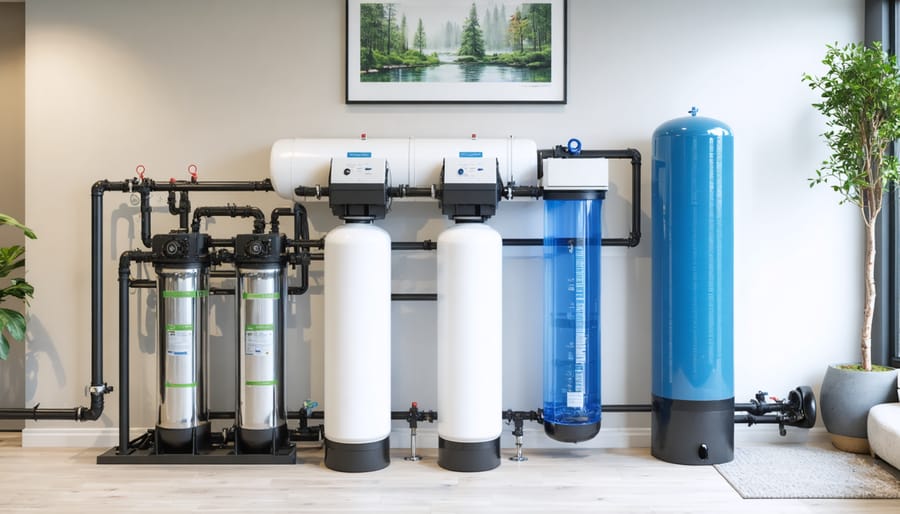
Installation and Maintenance Made Simple
DIY vs Professional Installation
While some DIY-savvy homeowners might be tempted to install their iron and manganese filtration system themselves, it’s important to carefully consider your skill level and local regulations before making this decision.
DIY installation can be suitable if you have experience with plumbing work and your system is relatively straightforward. Tasks you can typically handle include:
– Installing pre-assembled filter housings
– Connecting standard pipe fittings
– Basic system maintenance
– Filter replacements
– Simple water testing
However, professional installation is strongly recommended when:
– Your system requires electrical work
– Complex backwashing mechanisms are involved
– Local building codes require certified installers
– You need to modify existing plumbing
– The system includes automatic controls or smart features
Professional installers bring valuable expertise, ensuring proper system sizing, optimal placement, and compliance with local codes. They can also identify potential issues that might affect system performance and provide proper documentation for warranty purposes.
If you choose the DIY route, thoroughly review manufacturer instructions and local regulations first. Consider having a professional inspect your work after completion to ensure everything is installed correctly. Remember that improper installation can lead to leaks, reduced effectiveness, or even property damage, potentially costing more than professional installation in the long run.
Keeping Your System Running Efficiently
To maintain your filtration system effectively, follow a consistent maintenance schedule that ensures optimal performance. Check your pre-filter monthly and clean or replace it as needed – this simple step prevents larger particles from clogging the main filter media.
For iron and manganese systems, backwashing is crucial and should be performed every 2-4 days, depending on your water usage and contamination levels. Set your automatic backwash timer accordingly, but monitor the water quality to adjust the frequency if needed.
Inspect the air injection system quarterly to ensure proper oxidation of iron and manganese. Clean the air intake valve and check for any mineral buildup that might affect performance. Replace the air filter annually or as recommended by your manufacturer.
Test your water every three months using home testing kits to verify the system’s effectiveness. Pay attention to pressure gauge readings – a significant drop in pressure often indicates it’s time for maintenance.
Keep detailed maintenance records and set calendar reminders for regular tasks. Replace filter media every 3-5 years, though this varies based on water quality and usage. Consider scheduling professional maintenance annually to catch potential issues early and extend your system’s lifespan.
Remember to stock essential replacement parts and filters to avoid interruptions in water treatment. This proactive approach ensures consistent water quality and prevents costly repairs down the line.
Installing a whole house water filtration system for iron and manganese is a significant but worthwhile investment in your home’s water quality and your family’s well-being. By removing these problematic minerals, you’ll protect your plumbing fixtures, appliances, and clothing from unsightly stains while ensuring clean, clear water throughout your home.
Remember that the best system for your needs will depend on your specific water composition, household size, and budget. Whether you choose oxidation filtration, ion exchange, or a combination system, regular maintenance and proper installation are crucial for optimal performance and longevity.
Consider having your water professionally tested before making a final decision, as this will help you select the most effective treatment solution. While DIY installation is possible for experienced homeowners, professional installation ensures proper setup and compliance with local regulations.
By investing in a whole house filtration system, you’re not just solving immediate water quality issues – you’re making a long-term commitment to your home’s value and your family’s quality of life. The benefits of clean, iron and manganese-free water extend beyond clear drinking water to include protected appliances, better-tasting food and beverages, and spotless laundry.
Take action today to assess your water quality and explore the filtration options available to you. The sooner you address iron and manganese issues, the better protected your home will be.
